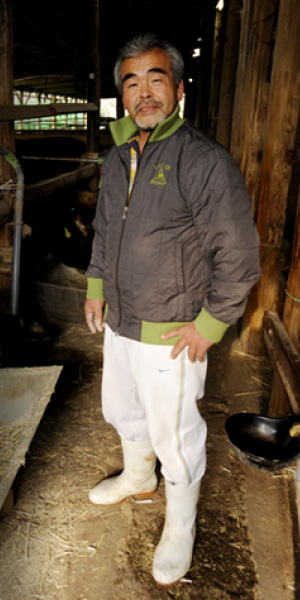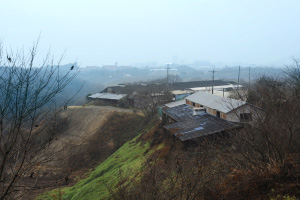- Single-minded devotion to breeding safe cattle
- The Nakanishi Farm is located in a remote ravine area to the west of Kobe City. Here, the charismatic cattle rearer Yoshinori Nakanishi produces about 15 champions every year.
Yoshinori Nakanishi says, “For me, personally, the most important thing is to produce good-tasting beef that my own family, grandchildren and friends can eat even every day confident that it is safe.” 30 years ago he came to realize the safety of pasture grasses as a source of cattle feed, long before zero—or low—agrichemical farm produce started gaining attention as it is doing today. He is, in fact, a seasoned traveler. He has flown overseas and participated in observation trips countless times in search of ideal pastures that use as few agrichemicals as possible. As a result of his persistent searching, he eventually found several types of pasture grasses that could be grown at a contract farm in the United States. He feeds his cows these grasses, slightly adjusting the blend depending on their physical condition. Suggesting just how confident he is, he says, “Thanks to that [feed], I think I have become the leading producer of livestock of consistent quality in Hyogo Prefecture these past ten years.” - What’s needed to breed the best cows?
- Specially selected feed. Fresh, fine-quality spring water drawn from aquifers 180 meters underground. Well-ventilated cowsheds that make full use of the surrounding undulating mountain terrain. All of these, of course, are vital. However, the strength of Yoshinori Nakanishi’s farm lies in the fact that he gradually reduces the number of cows made to share the same enclosure as they grow in age from eight to four, and then to two, and finally down to one cow when it is closer to their time to go to market.
“More than anything, Tajima-gyu cows are very sensitive. Subject them to stress and they won’t grow up as good animals. Occasionally, some cows don’t get along with the herd or frequently fight with others, so I have to figure out their compatibility with each other. In some cases, I separate them earlier and raise them alone. The main reason for doing this before they’re sent to market is to observe how each of them eats their feed and get a better idea of their physical shape.” He adds that it is because of the attention and care he devotes to each individual cow that he cannot increase the number of livestock on his farm.
“Of course, there are ways of raising them without having to go to these lengths. But, you must do what you have to do to produce the very best livestock. Each and every cow is different. Being the offspring of purebred seedstock cattle alone is just not enough; you, too, as a farmer have to put all of the skills you’ve got to 100% use.” - Distinct fat quality DNA
- Not only does Yoshinori Nakanishi eat the beef that he himself produces but he travels extensively and is always adventurous in sampling other various types of beef. Even based on his experiences, he asserts that “The fat quality DNA of Kobe beef is distinct. However much marbled Kobe beef you eat, you don’t get heartburn and the beef has a sweetness that it was meant to have.”
Incidentally, the probability of Kobe beef produced from Tajima-gyu cows being given the highest overall meat quality score of A5 is 10% in an average year. Yoshinori Nakanishi’s farm, however, manages to achieve an amazing percentage of 60%. He tries to keep his sights set high at all times. He says, “Before I send the cows to market, I try to make sure that they all have the same, consistent taste.” Even now, having handed over the ownership of the farm to his son, there is still no end to his passion for raising prime cattle.
 Upon graduating from high school, Yoshinori Nakanishi entered the family business of raising cattle which he has continued for close on 40 years. He now shares the running of the farm with his son.
Upon graduating from high school, Yoshinori Nakanishi entered the family business of raising cattle which he has continued for close on 40 years. He now shares the running of the farm with his son.














![[Nakanishi Farm]Yoshinori Nakanishi](img/2009-04.gif)